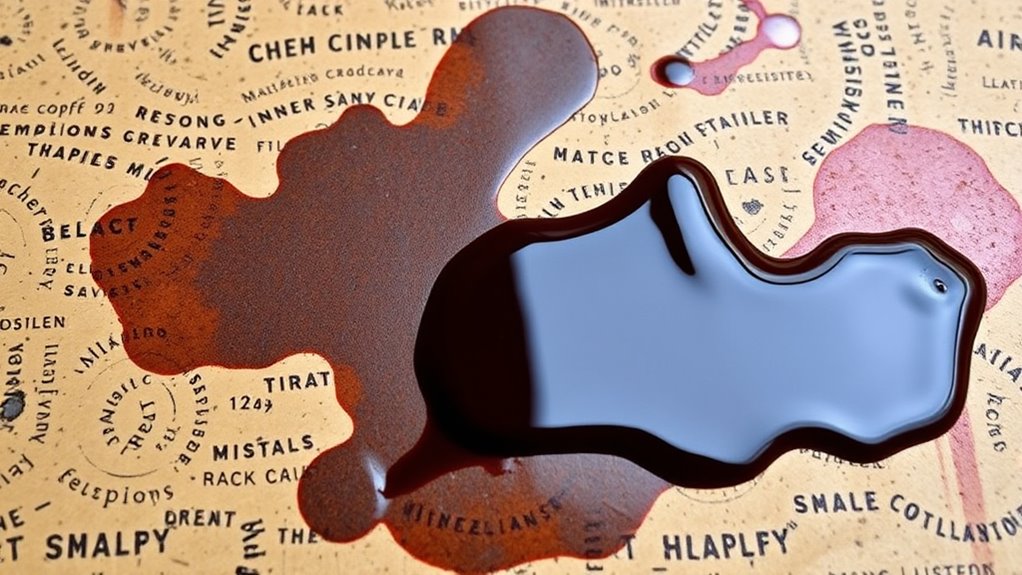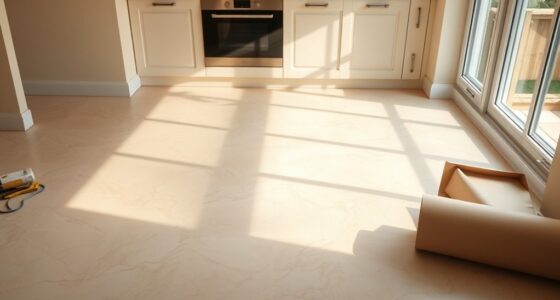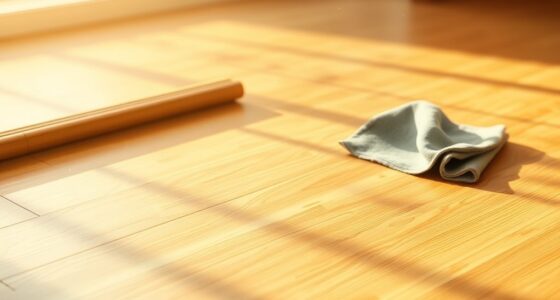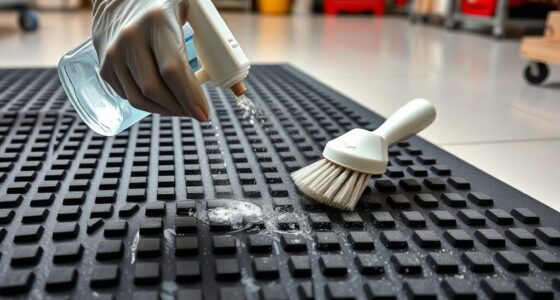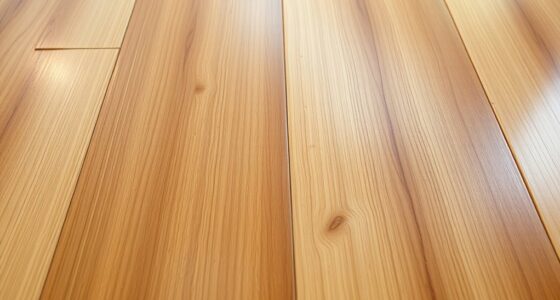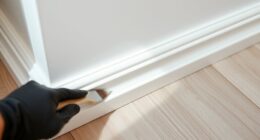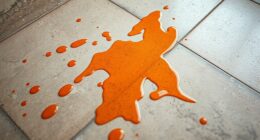To quickly remove coffee, wine, or grease stains from cork floors, act immediately by blotting the spill with a clean, damp microfiber cloth—avoid rubbing to prevent spreading. Use a mild cleaner formulated for cork, testing it first on a small area. Wipe gently and minimal water is best to avoid damage. Applying sealant regularly and quick cleanup helps prevent stains from setting, and if you keep exploring, you’ll discover more proven tips.
Key Takeaways
- Blot spills immediately with a clean, damp microfiber cloth to prevent stains from setting.
- Use mild, cork-specific cleaners and test on a small area before full application.
- For wine or coffee, gently blot and avoid rubbing to prevent spreading or damage.
- Remove grease stains with a specialized cleaner designed for stubborn stains on cork floors.
- Maintain regular cleaning and protect surfaces with sealant to reduce future stain risks.
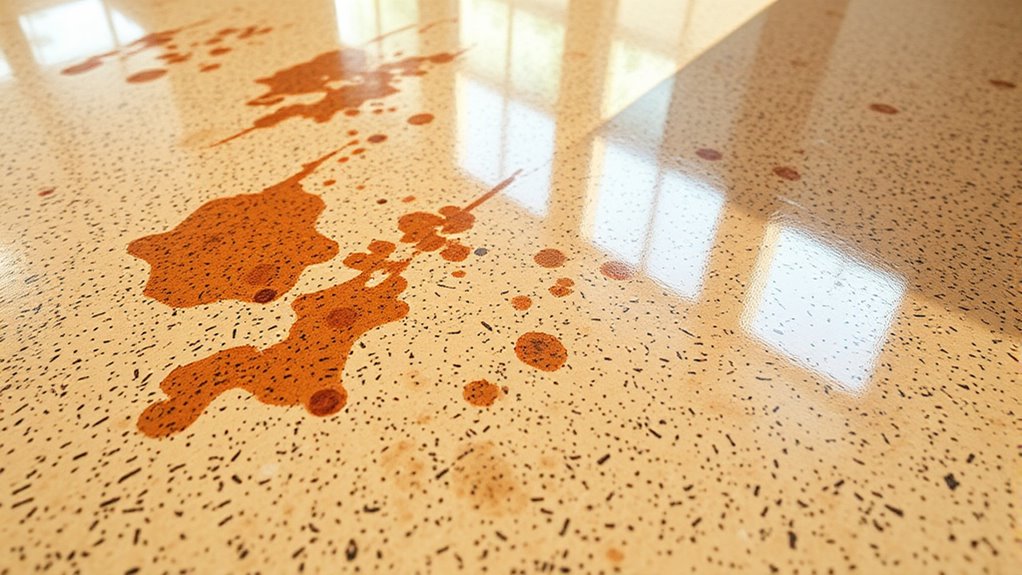
Cork floors add warmth and beauty to any space, but stains can quickly mar their appearance. When spills happen, acting fast is key to preventing permanent damage. To tackle stains effectively, you need the right cleaning tools and a good understanding of stain prevention. Having a soft cloth, a mild cleaner, and a damp mop on hand can make all the difference in maintaining your cork flooring’s charm.
Start by addressing spills immediately. For liquids like coffee or wine, gently blot the area with a clean, absorbent cloth—avoid rubbing, which can spread the stain or damage the cork’s surface. Using soft cleaning tools like a microfiber cloth ensures you lift the spill without scratching or damaging the cork. Once most of the liquid is absorbed, dampen your cloth with warm water mixed with a few drops of mild dish soap. Wring it out thoroughly so it’s just damp, not soaked, then wipe the stained area gently. This helps lift the stain without saturating the cork, which is *vital* since excess moisture can cause swelling or warping.
Address spills immediately with a gentle blot using a damp microfiber cloth to protect your cork floors.
Additionally, choosing the right cleaning agents is crucial; always opt for appropriate cleaners for cork floors**** to avoid damaging the finish. For tougher stains, like grease or stubborn wine spills, you might need a specialized cleaner formulated for cork floors. Always test a small, inconspicuous area first to ensure it won’t harm the finish. When cleaning, stick to the manufacturer’s recommended products and avoid harsh chemicals or abrasive tools that can scratch or dull the cork’s surface.
Prevention is just as important as cleaning. Using doormats at entry points reduces the amount of dirt and grit that can scratch your floors, while placing protective pads under furniture prevents scuffs. Be cautious with spills by cleaning them promptly, and consider applying a protective sealant periodically to add a barrier against stains. These simple steps help maintain your cork floors’ natural beauty and reduce the need for intensive stain removal.
Frequently Asked Questions
Can Cork Floors Be Sealed to Prevent Future Stains?
Yes, you can seal cork floors to prevent future stains through floor sealing. Applying a high-quality sealant creates a protective barrier, making it easier to wipe away spills and stains. Regularly resealing your cork floor ensures continued stain prevention and keeps it looking great. Make sure to choose a sealant suitable for cork, follow application instructions carefully, and maintain the sealant to maximize stain resistance and prolong your floor’s lifespan.
Are DIY Stain Removal Methods Safe for Cork Floors?
DIY stain removal methods can be safe for cork floors if you prioritize DIY safety and consider chemical compatibility. Always test a small, hidden area before applying any cleaning solution to prevent damage. Use gentle, non-abrasive cleaners like mild soap and water, and avoid harsh chemicals that can harm cork. Following proper safety measures guarantees your DIY stain removal is effective without risking your cork floor’s integrity.
How Often Should Cork Floors Be Resealed After Staining?
Oh, because waiting forever is exactly what you want, right? In reality, you should reseal your cork floors every 1 to 3 years, based on the sealing frequency and wear. A consistent resealing schedule guards your floors from stains and damage, maintaining their beauty and durability. Don’t ignore it—sticking to this schedule ensures your cork floors stay stunning and protected over time.
What Professional Treatments Are Recommended for Stubborn Stains?
For stubborn stains, consider professional cleaning services that specialize in stain removal techniques for cork floors. These experts use specialized solutions and equipment to effectively lift deep-seated stains like coffee, wine, or grease without damaging the surface. You should avoid harsh chemicals and instead trust professionals who can assess the stain and apply the appropriate treatment, ensuring your cork floors look their best again while preserving their integrity.
Are There Specific Cleaning Products Best Suited for Cork Floors?
Are you wondering if there are specific cleaning products for cork floors? Yes, opt for gentle cleaning solutions designed for delicate surfaces—look for pH-neutral cleaners that prevent damage. These products help with stain prevention and keep your cork flooring looking fresh. Always test a small area first, and avoid harsh chemicals. Do you want your floors to stay beautiful longer? Proper cleaning solutions make all the difference!
Conclusion
Now you’re equipped to banish stains from your cork floors faster than a superhero saving the day. With these simple tricks, you’ll turn stubborn coffee, wine, or grease marks into distant memories — almost like waving a magic wand! Remember, a little quick action can save your floors from permanent damage and keep them looking stunning for years. So go ahead, conquer those stains and enjoy your beautiful, spotless cork floors like the flooring superstar you are!
